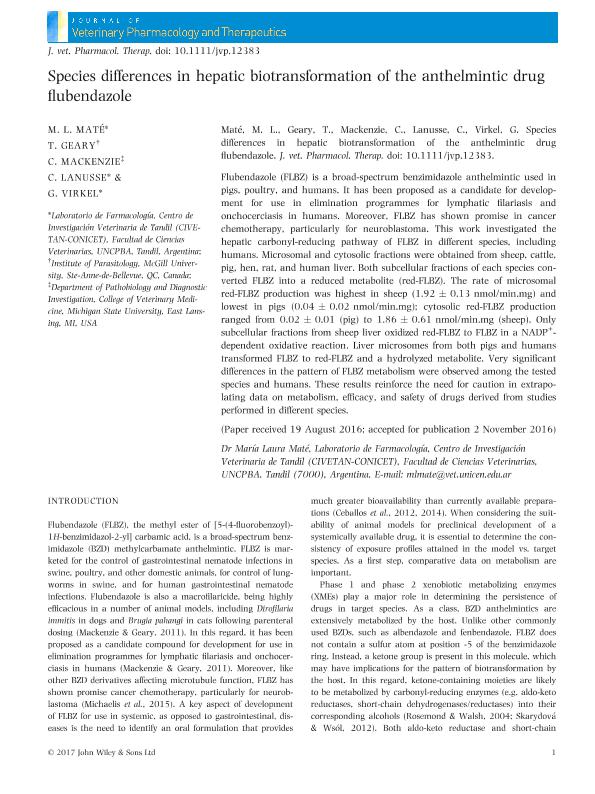Artículo
Species differences in hepatic biotransformation of the anthelmintic drug flubendazole
Fecha de publicación:
10/2017
Editorial:
Wiley Blackwell Publishing, Inc
Revista:
Journal of Veterinary Pharmacology and Therapeutics
ISSN:
0140-7783
Idioma:
Inglés
Tipo de recurso:
Artículo publicado
Clasificación temática:
Resumen
Flubendazole (FLBZ) is a broad-spectrum benzimidazole anthelmintic used in pigs, poultry, and humans. It has been proposed as a candidate for development for use in elimination programmes for lymphatic filariasis and onchocerciasis in humans. Moreover, FLBZ has shown promise in cancer chemotherapy, particularly for neuroblastoma. This work investigated the hepatic carbonyl-reducing pathway of FLBZ in different species, including humans. Microsomal and cytosolic fractions were obtained from sheep, cattle, pig, hen, rat, and human liver. Both subcellular fractions of each species converted FLBZ into a reduced metabolite (red-FLBZ). The rate of microsomal red-FLBZ production was highest in sheep (1.92 ± 0.13 nmol/min.mg) and lowest in pigs (0.04 ± 0.02 nmol/min.mg); cytosolic red-FLBZ production ranged from 0.02 ± 0.01 (pig) to 1.86 ± 0.61 nmol/min.mg (sheep). Only subcellular fractions from sheep liver oxidized red-FLBZ to FLBZ in a NADP+-dependent oxidative reaction. Liver microsomes from both pigs and humans transformed FLBZ to red-FLBZ and a hydrolyzed metabolite. Very significant differences in the pattern of FLBZ metabolism were observed among the tested species and humans. These results reinforce the need for caution in extrapolating data on metabolism, efficacy, and safety of drugs derived from studies performed in different species.
Palabras clave:
Flubendazole
,
Anthelmintics
,
Biotransformation
,
Species Differences
Archivos asociados
Licencia
Identificadores
Colecciones
Articulos(CCT - TANDIL)
Articulos de CTRO CIENTIFICO TECNOLOGICO CONICET - TANDIL
Articulos de CTRO CIENTIFICO TECNOLOGICO CONICET - TANDIL
Articulos(CIVETAN)
Articulos de CENTRO DE INVESTIGACION VETERINARIA DE TANDIL
Articulos de CENTRO DE INVESTIGACION VETERINARIA DE TANDIL
Citación
Maté, María Laura; Geary, T.; Mackenzie, C.; Lanusse, Carlos Edmundo; Virkel, Guillermo Leon; Species differences in hepatic biotransformation of the anthelmintic drug flubendazole; Wiley Blackwell Publishing, Inc; Journal of Veterinary Pharmacology and Therapeutics; 40; 5; 10-2017; 493-499
Compartir
Altmétricas




